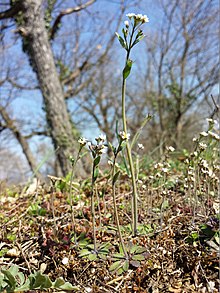Arabidopsis (rockcress) is a genus in the family Brassicaceae. They are small flowering plants related to cabbage and mustard. This genus is of great interest since it contains thale cress (Arabidopsis thaliana), one of the model organisms used for studying plant biology and the first plant to have its entire genome sequenced. Changes in thale cress are easily observed, making it a very useful model.
| Arabidopsis | |
|---|---|

| |
| Thale cress (Arabidopsis thaliana) | |
| Scientific classification | |
| Kingdom: | Plantae |
| Clade: | Tracheophytes |
| Clade: | Angiosperms |
| Clade: | Eudicots |
| Clade: | Rosids |
| Order: | Brassicales |
| Family: | Brassicaceae |
| Genus: | Arabidopsis Heynh. in Holl & Heynh. |
| Type species | |
| Arabidopsis thaliana L. | |
| Species | |
|
See text | |
| Synonyms | |
|
Cardaminopsis (C.A.Mey.) Hayek | |
Currently, the genus Arabidopsis has nine species and a further eight subspecies recognised. This delimitation is quite recent and is based on morphological and molecular phylogenies by O'Kane and Al-Shehbaz[1][2] and others.
Their findings confirm the species formerly included in Arabidopsis made it polyphyletic. The most recent reclassification moves two species previously placed in Cardaminopsis and Hylandra and three species of Arabis into Arabidopsis, but excludes 50 that have been moved into the new genera Beringia, Crucihimalaya, Ianhedgea, Olimarabidopsis, and Pseudoarabidopsis.
All of the species in Arabidopsis are indigenous to Europe, while two of the species have broad ranges also extending into North America and Asia.
In the last two decades, Arabidopsis thaliana has gained much interest from the scientific community as a model organism for research on numerous aspects of plant biology. The Arabidopsis Information Resource (TAIR) is a curated online information source for Arabidopsis thaliana genetic and molecular biology research, and The Arabidopsis Book[3] is an online compilation of invited chapters on Arabidopsis thaliana biology. (Note that as of 2013 no further chapters will be published.) In Europe, the model organism resource centre for Arabidopsis thaliana germplasm, bioinformatics and molecular biology resources (including GeneChips) is the Nottingham Arabidopsis Stock Centre (NASC) whilst in North America germplasm services are provided by the Arabidopsis Biological Resource Center (ABRC) based at Ohio State University. The ordering system for ABRC was incorporated into the TAIR database in June 2001 whilst NASC has always (since 1991) hosted its own ordering system and genome browser.
In 1982, the crew of the Soviet Salyut 7 space station grew some Arabidopsis, thus becoming the first plants to flower and produce seeds in space. They had a life span of 40 days.[4] Arabidopsis thaliana seeds were taken to the Moon on the Chang'e 4 lander in 2019, as part of a student experiment. As of May 2022 Arabidopsis thaliana has successfully been grown in samples of lunar soil.[5]
Arabidopsis is quite similar to the Boechera genus.
The following species previously placed in Arabidopsis are not currently considered part of the genus.
Cytogenetic analysis has shown the haploid chromosome number (n) is variable and varies across species in the genus:[6]
A. thaliana is n=5[7] and the DNA sequencing of this species was completed in 2001. A. lyrata has n=8 but some subspecies or populations are tetraploid.[8] Various subspecies A. arenosa have n=8 but can be either 2n (diploid) or 4n (tetraploid).[9] A. suecica is n=13 (5+8) and is an amphidiploid species originated through hybridization between A. thaliana and diploid A. arenosa.[10]
A. neglecta is n=8, as are the various subspecies of A. halleri.[9]
As of 2005, A. cebennensis, A. croatica and A. pedemontana have not been investigated cytologically.
{{cite book}}: |journal= ignored (help)